Can I Give My Baby Chicks an Earthworm?
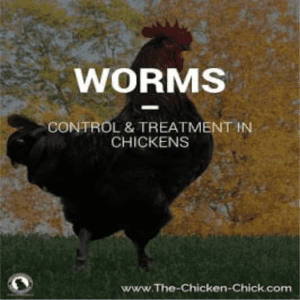
Whether, when and how to deworm backyard chickens are difficult questions for the boilerplate craven keeper to answer. To a large extent, the answers are a affair of personal philosophy, but how does one form a philosophy without a degree in poultry medicine? Almost of usa really only want the basics: how chickens get worms, how to recognize a worm trouble, how to control and care for chickens for worms when necessary. I offer a few chicken worm basics here with plenty-o-links to delve deeper into the wiggly world of poultry internal parasites should you so desire. My objective is to provide enough data for you understand the basics about worms in chickens so you can form a worm control philosophy for your flock.

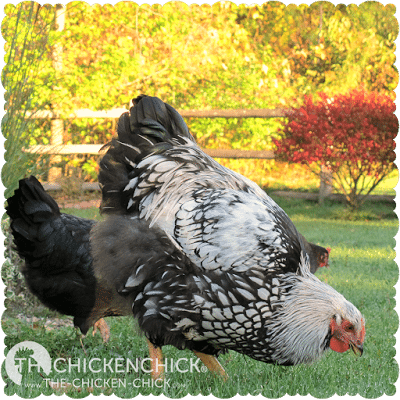
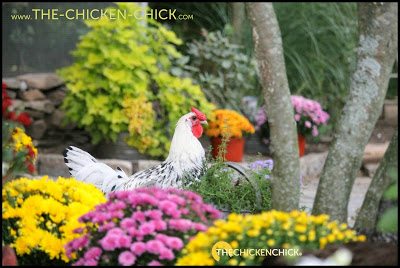
I consulted with board certified poultry veterinarians and a board certified veterinary pathologist while writing this article. While well-nigh of the treatment information below is regularly distributed by ane of the vets to their patients, their legal department prefers no attribution. (Lawyers ruin all the fun.) I'll take whatever information I can go for my chickens and yours from highly regarded and experienced poultry veterinarians though.
HOW DO CHICKENS Become WORMS?
Basically, chickens become worms from something they eat. Either a chicken eats infected droppings from another bird or the chicken eats an insect carrying worm eggs (earthworm, slug, snail, grasshopper, wing, etc). A good for you chicken can manage a reasonable worm load. When the chicken gets sick or otherwise stressed, their immune system is taxed and internal parasites have the opportunity to overpopulate. Worms inside a chicken aren't aren't always a trouble, but when they are, they can cause disease, infection and decease.
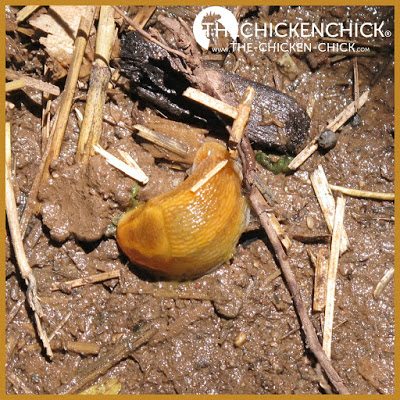
Slugs are an intermediate host, which means they behave one or more than parasites that will infect a craven only when the chicken eats the host.
WHAT KIND OF WORMS ARE WE TALKING About?
At that place are simply a handful of worms that lawn chicken keepers demand to concern themselves with ordinarily: capillary worms, cecal worms, gapeworms, roundworms and tapeworms. "There are several types of worms that cause infections, but few worms cause true disease in hens. (H)ens will often carry quite a load of worms earlier showing whatsoever signs." Dr. Mike Petrik, DVM, MSc
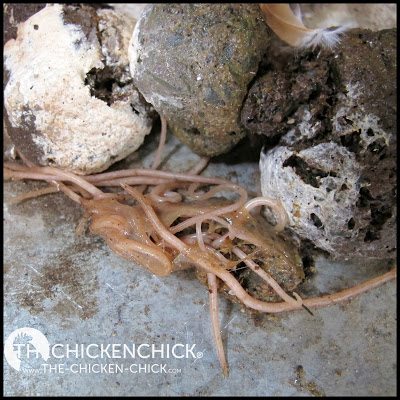
Roundworms (Ascaridia galli):
Roundworms are very common in lawn chickens. Heavy loads are visible in debris, can be up to ~3″ long. Live in the modest intestine & interfere with chicken's power to absorb nutrients; larvae damage the intestine walls, adults can create a blockage in the intestines, causing death. Roundworms cannot be transmitted from chickens to humans.The treatment of choice is piperazine.
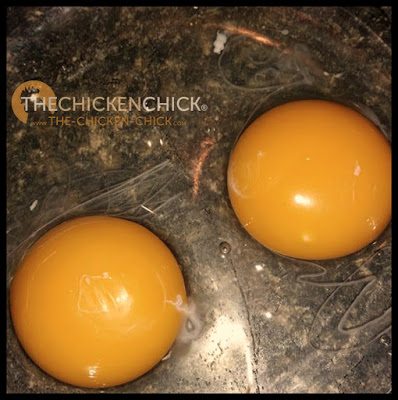
Capillary Worms, aka: Hairworms, Threadworms (Capillaria):
Very thin, thread-like worms no more .v″ long. Alive in various torso parts of chickens (crop, espohagus and intestines. Not ordinarily visible in droppings. Contracted through earthworms or picked upwards in litter. Can rob chickens of nutrients and vitamins.
Cecal worms (Heterakis gallinae):
Very common, non commonly harmful to chickens. Alive in ceca (2 branches off the intestine that end in 2 lilliputian pouches; the ceca are where the super stinky poop is made.). Visible with naked eye, ~.5″ long. Cecal worms are not commonly detrimental to chicken wellness. Cecal worms cannot be transmitted from chickens to humans.The cecal worm tin can be effectively treated with fenbendazole.
![Worms | By Milton Friend at the Geological Survey National Wildlife Health Center [Public domain], via Wikimedia Commons](https://the-chicken-chick.com/wp-content/uploads/2015/11/gapeworms.jpg)
Gapeworms (Syngamus trachea):
Gapeworms are not very mutual in chickens. They live in the trachea, cause a chicken to open up its mouth repeatedly, stretch its neck, gasp, cough or shake its head trying to dislodge the worms. Gapeworms have a red, fork-shaped appearance and are visible with naked eye. Transmitted by earthworms, slugs, flies and beetles. Crave special treatment repeated over a period of 3 weeks. (Panacur, Ivermectin) Gapeworms cannot be transmitted from chickens to humans.
![Worms | By The original uploader was Chhandama at English Wikipedia (Transferred from en.wikipedia to Commons.) [CC BY 3.0 (http://creativecommons.org/licenses/by/3.0)], via Wikimedia Commons](https://the-chicken-chick.com/wp-content/uploads/2015/11/Tapeworm.jpg)
Tapeworms (Cestodes):
Tapeworms are common in chickens. Live in different areas of the intestines. Transmitted by beetles, earthworms, flies, slugs, etc. Require special treatment (Valbazen) and control of manual sources. Hard to care for, command transmission sources. B enzimidazoles, eg: fenbendazole or leviamisole, are the drugs of pick in treating chickens for tapeworms. Tapeworms cannot be transmitted from chickens to humans.
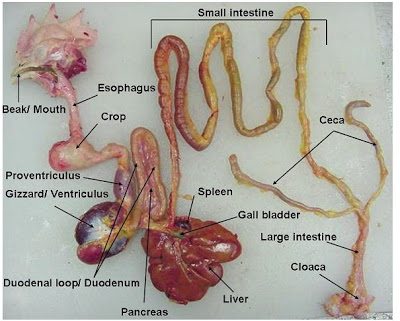
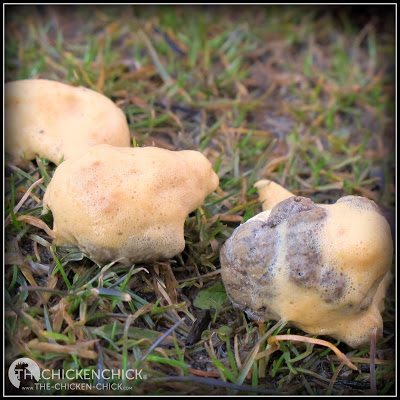
DETECTION
Symptoms of a worm infestation in chickens can include: worms in eggs, abnormal droppings, (diarrhea, foamy-looking, etc) weight loss, pale comb/wattles, listlessness, abnormal droppings, dirty vent feathers, worms in debris or throat, gasping, head-stretching and shaking, reduced egg production and sudden death.
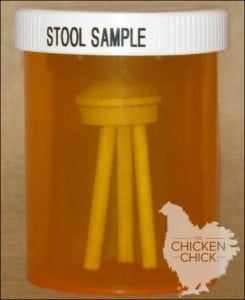
If birds are suspected of having a worm overload, a debris sample should be brought to a veterinarian for afecal bladder exam. The vet tin can send the test directly to their lab for you. The test will reveal whether there is a problem, how serious it is and which type of worms are plaguing the bird.
It is important to understand that Not all de-worming medications are capable of treating all types of worms.
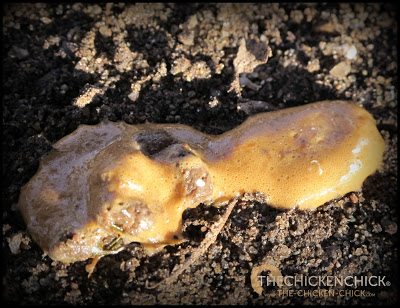
WORM PREVENTION/CONTROL Best PRACTICES
The best way to avoid having to concern yourself with a worm over-load is to proceed the birds healthy; a good for you chicken tin can control a reasonable load of worms in its digestive tract.
- DO feed chickens properly. Limit treats to five% of their daily nutrition and don't add ingredients to a quality commercial ration considering doing then dilutes the carefully calculated nutritional balance in the feed.
- DON'T throw craven feed or treats on the ground where information technology tin can become contaminated with infected droppings.
- DON'T overcrowd chickens in a coop or run.
- DO keep feeders clean.
- DO provide clean, fresh h2o daily and keep containers clean. Consider using a poultry nipple drinker.
- DO keep a make clean coop. Don't let debris to accumulate. Use of a droppings boardunderneath roosts catches the night's droppings, keeping litter cleaner, longer and provides an opportunity to observe abnormalities such as worms.
- DO keep stress to a minimum. Stress taxes a chicken'due south allowed system, allowing worms to capitalize on the reduced resistance.
- Practice provide flock with a sunny, well-tuckered yard.
- Do rotate pasture/pens/yards periodically. Chickens raised calendar month after month on the same area at college run a risk for contracting illness, disease and parasites than properly pastured birds given admission to clean basis regularly.
- DO remove coop and pen litter & supercede periodically to break parasites' life-cycles. (I replace the sand in my coops and runs at least once a yr, if not twice)
- Practise contact your state Department of Agriculture Extension service poultry agent to talk over ecology specifics in your area and whether they lend themselves to a regular de-worming programme and if so, what that should await like (contact information can be plantHERE).
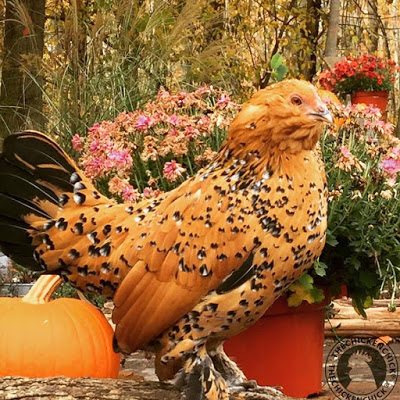
TREATMENT
Any time ane chicken in a flock has a worm overload or is existence treated for a suspected worm infestation, every member of the flock should exist treated
Co-ordinate to Dr. Mike, The Chicken Vet, "The best strategy is to control worms twice per year: in one case in the fall, and once in the spring. To keep resistance from developing, you should rotate ii or 3 of them in a program. Use product A in the fall, Product B in the jump, Production C in the following jump….etc."Dr. Mike Petrik, DVM, MSc
Select one product that targets the type of worm plaguing your chickens and always treat the flock twice – one time to paralyze and evict the adult parasites and again in 7-14 days (depending on the production) to eradicate the worms that have hatched from eggs since the beginning treatment. Make clean the litter in the coop and run after the second treatment.
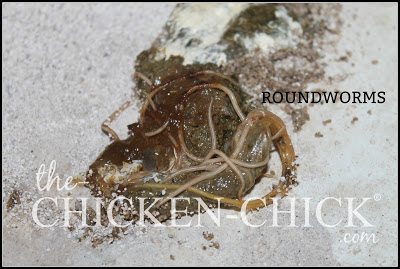
"You lot will encounter roundworms on the ground subsequently deworming if they had a roundworm infestation. If you don't encounter whatever, information technology doesn't injure the birds to de-worm anyway." Dr. Michael Darre, MS, PhD, Poultry Professor, University of Connecticut
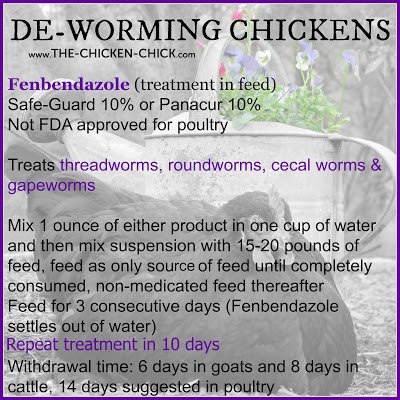
Safety-guard (fenbendazole) 10% treats threadworms, roundworms, cecal worms and gapeworms. Dosage for paste version : place a pea-sized dollop in nib or inside a slice of staff of life.
Repeat handling in 10 days.

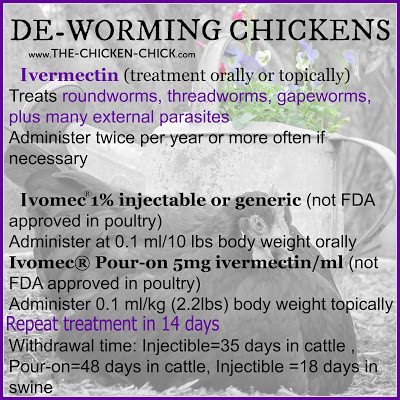
Ivermectin pour-on, applied to the back of craven's neck; 1 driblet for tiny chickens, iii drops for bantams, 4 for lightweight birds, 5 for large birds and 6 for heavy breeds.
Repeat handling in 14 days.
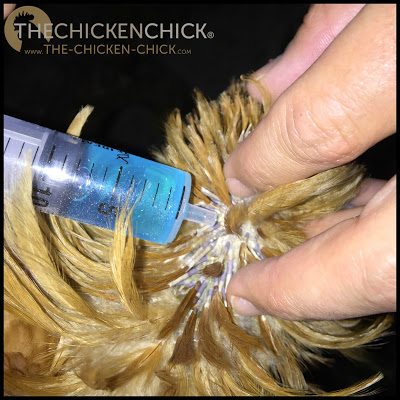
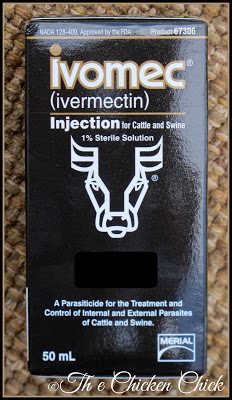
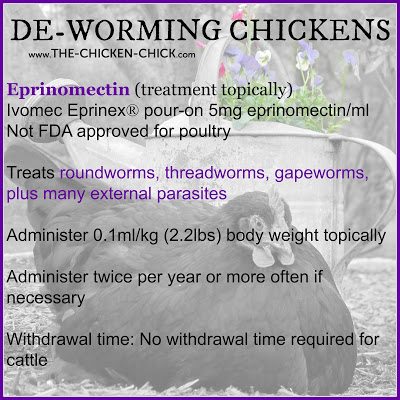
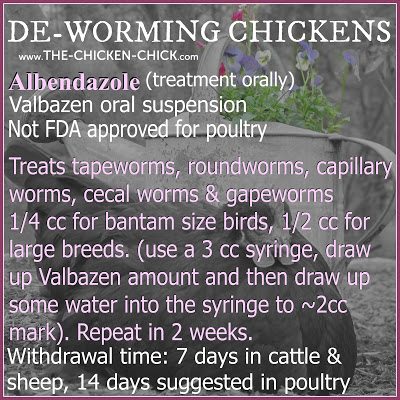
Valbazen Drench, treats tapeworms, roundworms, capillary worms, cecal worms & gapeworms. Oral dosages: 1/2 cc for large breeds, 1/4 cc for bantam sized birds. Use a3cc syringe, draw up Valbazen dosage and then describe up some water into the syringe to approximately the 2cc mark for oral administration or soaked into bread and fed to birds individually.
Repeat handling in 14 days.
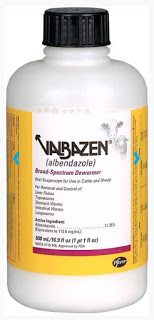
Virtually EGG WITHDRAWAL PERIODS
A withdrawal menstruum is the minimum number of days that must pass from the fourth dimension a chicken stops receiving a drug until the drug residue remaining in its trunk is reduced in its eggs or meat to an "acceptable level" to be safety for human being consumption according to USDA standards. (paraphrased from The Chicken Encyclopedia ) "If you lot cannot decide a specific drug's withdrawal catamenia, let at to the lowest degree xxx days" earlier eating eggs or meat from a treated chicken." Gail Damerow, The Chicken Encyclopedia
According to Dr. Petrick, The Chicken Vet, "Most worm medications accept no [information about egg withdrawal periods] for laying hens. The reality is that most of the products are safe, and virtually don't even get into the egg ….they are medications that affect the gut and seldom are absorbed into the bloodstream. The problem is that at that place is no proof of their prophylactic. Levamisole,fenbendazole (Prophylactic-guard) andhygromycin are all constructive anthelminthics (anti-worm drugs). To keep resistance from developing, yous should rotate 2 or 3 of them in a program. Use product A in the fall, Product B in the spring, Production C in the following spring….etc."
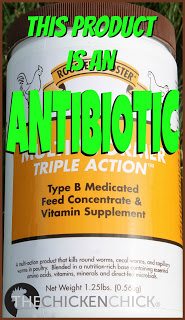
"Rooster Booster MultiWormer" is frequently used by folks hoping for a "more than natural" de-wormer, however, what most do not realize is that information technology contains the antibiotic, Hygromycin B and it is not a treatment for a worm overload so much as a preventative to control the amount of worms in the digestive tract with continuous apply. A one.25 lb container costs upwards of ~$25 and must be fed to the flockevery twenty-four hour period for weeks to begin to control the population of only a few types of worms: capillary, cecal and roundworms. In practical terms, that adds $25 to every bag of craven feed forever and will not begin working to reduce a worm overpopulation for many weeks in infested chickens.
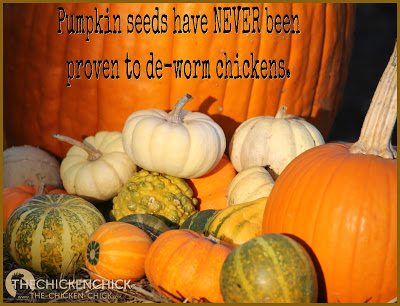
A FEW WORDS Well-nigh THE GREAT PUMPKIN Claim
According to Gail Damerow in The Chicken Health Handbook, two Ed." Natural methods of worm control differ from chemical dewormers in not paralyzing or killing existing parasites but rather work by making the surround inside the chicken less attractive, or downright unpleasant, for parasites to take up residence. They are therefore more suited to preventing worms than to removing an existing worm load ."
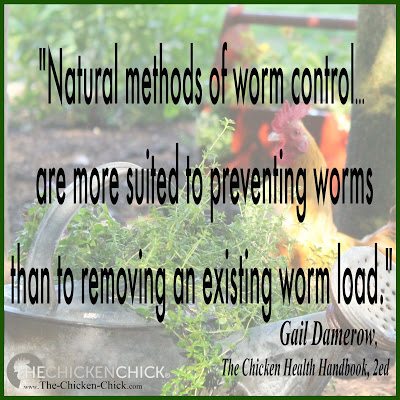
There is NO scientific show anywhere suggesting that the active ingredient in pumpkin seeds (Curcurbitin) is capable of deworming or reducing worm loads in chickens. If I had roundworms in my digestive tract, I would not exist willing to wage a bet that pumpkin seeds would eradicate the infestation in my gut, similarly, I am not willing to cause my chickens to suffer with a known worm overload while testing a theory with no prove to support it.
Beware of the statement "I feed my chickens pumpkin seeds and they have never had worms therefore, pumpkin seeds are an constructive, natural dewormer." All backyard chickens deport some load of worms and healthy chickens can manage a normal worm load whether or not they eat pumpkins or pumpkin seeds. Read Much more than on this topic hither.
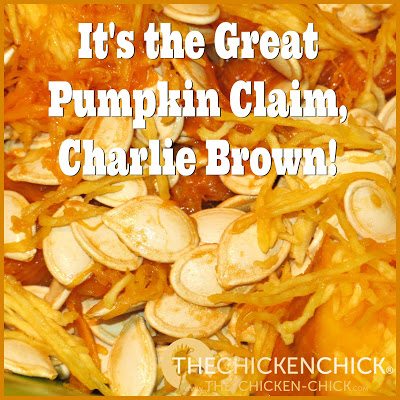
Whatever fourth dimension a claim virtually pumpkins being a "natural de-wormer" is found, inquire for specifics such as:
- Will the claimed effect be a complete de-worming of the craven or merely a reduction in the number of worms in the chickens' digestive tract?
- When will the claimed consequence occur?
- Which of the five species of Cucurbita (pumpkins) should be used and which variety inside the nine cultivar groups should be used?
- What's the needed percentage of Curcurbitin in the pumpkin seeds? How tin the per centum be tested for?
- What quantity of pumpkin seeds should exist fed per day per craven?
- How oft should the pumpkin seeds be fed to chickens to have the claimed issue?
Nobody has the answers to those questions. If they did, they'd be sitting on a beach in Hawaii, sipping a cold beverage paid for with the proceeds from the sales of the natural chicken de-worming product they patented and we all would be using it already.
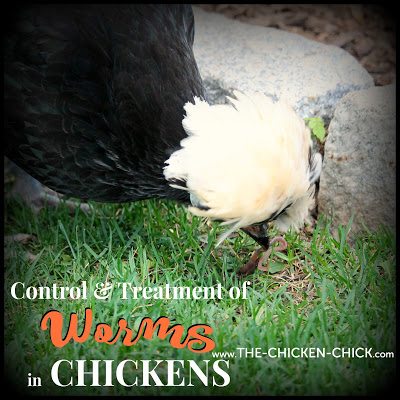
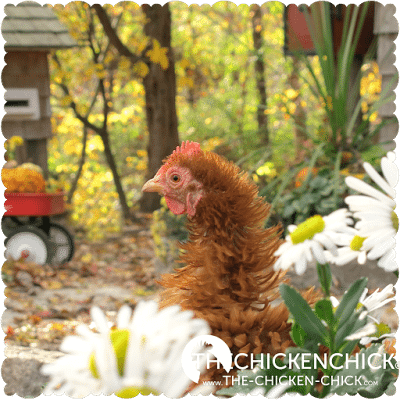
Sources & Further Reading:
i The Apha Practical Guide to Natural Medicines: The First Administrative Habitation Reference For Herbs And Natural Remedies, Andrea Pierce, HarperCollins, 1999.
2 Dewormer Adjuncts, Control Without, or Along With, Chemicals, Karen Briggs with Craig Reinemeyer, DVM, PHD; Dennis French, DVM, MS, DIPL, ABVP; and Ray Kaplan, DVM, PHD. world wide web.TheHorse.com, October 2004
Internal Parasites of Poultry
Internal Parasites
The Chicken Health Handbook
Poultry Production in Mississippi, Parasitic Diseases (internal)
Worming Treatments
Poultry Diseases & Medications for Small-scale Flocks
Roundworms
The Craven Encyclopedia
Gapeworms
The Craven Health Handbook, 2edFDA, Piperazine
Benzimidazoles
Leopold Middle for Sustainable Agriculture Study: DE
Overview of Helminthiasis in PoultryThe Informed Poultry Professional, University of Georgia
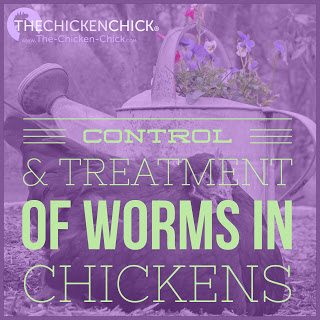
*Anatomical illustrations and photograph reproduced for educational purposes, courtesy of Jacquie Jacob, Tony Pescatore and Austin Cantor, University of Kentucky College of Agriculture. Copyright 2011. Educational programs of Kentucky Cooperative Extension serve all people regardless of race, color, age, sex activity, religion, inability, or national origin. Issued in furtherance of Cooperative Extension work, Acts of May 8 and June 30, 1914, in cooperation with the U.S. Department of Agronomics, Grand. Scott Smith, Director, Country Grant Programs, University of Kentucky College of Agriculture, Lexington,and Kentucky State University, Frankfort. Copyright 2011 for materials developed by University of Kentucky Cooperative Extension. This publication may be reproduced in portions or its entirety for educational and nonprofit purposes merely. Permitted users shall give credit to the author(s) and include this copyright notice. Publications are too available on the World Wide Spider web at world wide web.ca.uky.edu. Issued 02-2011


You May Also Like
Source: https://the-chicken-chick.com/control-treatment-of-worms-in-chickens/
0 Response to "Can I Give My Baby Chicks an Earthworm?"
Postar um comentário